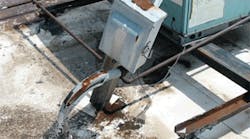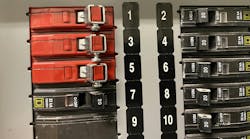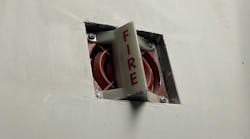How well do you know the Code? Think you can spot violations the original installer either ignored or couldn’t identify? Here’s your chance to moonlight as an electrical inspector and second-guess someone else’s work from the safety of your living room or office. Can you identify the Code violation(s) in this photo?
Hint: Overexposed and unstable
Find the Answer
March Winners
Our three winners this month were: Bob Allsbrook, project manager, Pedro Falcon Electrical Contractors, Inc., Big Pine Key, Fla.; David James, Puckett Electric, Durango, Colo.; and David Martinez, journeyman electrician, JM Electric, Salinas, Calif. This group identified the following violations associated with this unusual pole-mounted meter can.
• Plumbing pipe elbows are not approved for use as an electrical conduit. As per 352.6, “PVC conduit, factory elbows, and associated fittings shall be listed.” Also see 352.2 for the definition of rigid polyvinyl chloride conduit (PVC) and 352.100 for the construction specifications of PVC.
• These plumbing pipe elbows do not meet the radius criteria of Table 2 in Chapter 9. As per 352.24, “The radius of the curve to the centerline of such bends shall not be less than shown in Table 2, Chapter 9.”
• The plumbing pipe fitting at the meter socket enclosure does not meet the requirements of 352.48, which states, “All joints between lengths of conduit, and between conduit and couplings, fittings, and boxes, shall be made by an approved method.” In addition, 312.2 requires meter enclosures installed in wet locations to be installed in such a manner to prevent moisture from entering.
• A review of 352.10 and 352.12 would also be beneficial, as these sections of the Code outline where you can and cannot use PVC conduit.
‘TELL THEM WHAT THEY'VE WON…’
Using the 2008 NEC, correctly identify the Code violation(s) in this month’s photo — in 200 words or less — and you could win something to put in your tool box. E-mail your response to [email protected], and we’ll select three winners (excluding manufacturers and prior winners) at random from the correct submissions. Winners will receive a set of insulated hand tools from Ideal Industries, Inc., valued at more than $125.* The set includes 9.25-in. insulated side-cutting pliers, 10-in. insulated tongueand- groove pliers, and a 0.25-in. x 6-in. insulated screwdriver. (* Please allow six to eight weeks for delivery of tools.)





